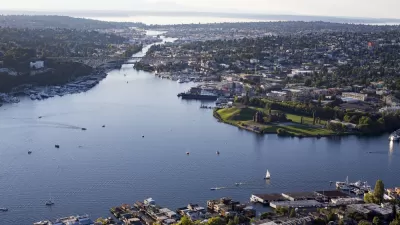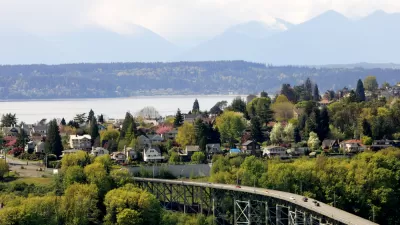A proposed bill in the Washington state legislature that would legalize more multi-family housing in the state could add hundreds of thousands of units to the state's strained housing stock.

A proposed bill in the Washington state legislature would open the door to more "missing middle housing" in the state, reports Dan Bertolet. "A new bill would not only help correct the historic injustice of zoning laws originally enacted to exclude Black families, but also would relieve the root cause of Washington’s housing crisis: a shortage of homes."
The law would lift local laws that ban multi-family buildings, legalizing denser housing based on its location, local population, and proximity to transit. Based on a California study, this could lead to the construction of more than 200,000 units in Washington. "For a second comparison, a recent University of Washington report estimated that legalizing fourplexes within a quarter-mile of transit stations would create capacity for nearly half a million more homes in the Puget Sound region, which is home to 4.3 million of the state’s 7.6 million residents."
The proposed bill would also limit parking requirements to reduce the cost of construction and encourage multi-modal transportation and transit use. Further, the bill attempts to prevent displacement by requiring citied to adhere to the anti-displacement standards enacted by the state in 2021.
According to the source article, linked below, Washington's proposed legislation differs in key ways from similar laws in California and Oregon, notably by permitting six-unit buildings near transit. While it excludes unincorporated areas and gives cities a minimum density alternative that could let some localities perpetuate exclusionary zoning, the bill has the potential to create hundreds of thousands of new homes for Washingtonians.
FULL STORY: WASHINGTON BILL WOULD LEGALIZE HUNDREDS OF THOUSANDS MORE HOMES

Study: Maui’s Plan to Convert Vacation Rentals to Long-Term Housing Could Cause Nearly $1 Billion Economic Loss
The plan would reduce visitor accommodation by 25,% resulting in 1,900 jobs lost.

North Texas Transit Leaders Tout Benefits of TOD for Growing Region
At a summit focused on transit-oriented development, policymakers discussed how North Texas’ expanded light rail system can serve as a tool for economic growth.

Why Should We Subsidize Public Transportation?
Many public transit agencies face financial stress due to rising costs, declining fare revenue, and declining subsidies. Transit advocates must provide a strong business case for increasing public transit funding.

How to Make US Trains Faster
Changes to boarding platforms and a switch to electric trains could improve U.S. passenger rail service without the added cost of high-speed rail.

Columbia’s Revitalized ‘Loop’ Is a Hub for Local Entrepreneurs
A focus on small businesses is helping a commercial corridor in Columbia, Missouri thrive.

Invasive Insect Threatens Minnesota’s Ash Forests
The Emerald Ash Borer is a rapidly spreading invasive pest threatening Minnesota’s ash trees, and homeowners are encouraged to plant diverse replacement species, avoid moving ash firewood, and monitor for signs of infestation.
Urban Design for Planners 1: Software Tools
This six-course series explores essential urban design concepts using open source software and equips planners with the tools they need to participate fully in the urban design process.
Planning for Universal Design
Learn the tools for implementing Universal Design in planning regulations.
Ascent Environmental
Borough of Carlisle
Institute for Housing and Urban Development Studies (IHS)
City of Grandview
Harvard GSD Executive Education
Toledo-Lucas County Plan Commissions
Salt Lake City
NYU Wagner Graduate School of Public Service





























